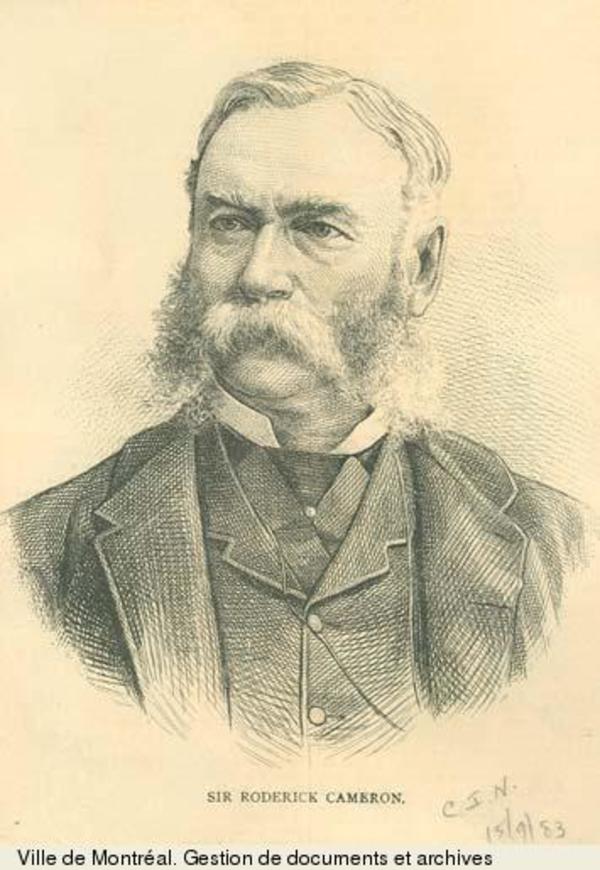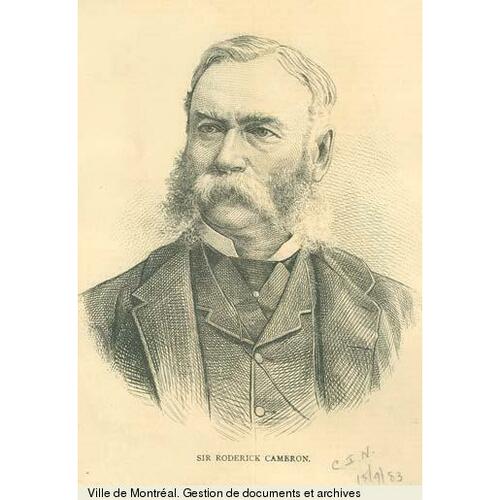
Source: Link
CAMERON, Sir RODERICK WILLIAM, businessman, lobbyist, and exhibition commissioner; b. 25 July 1823 in Glengarry County, Upper Canada, son of Duncan Cameron* and Margaret McLeod; m. first 6 Aug. 1845 Mary Ann Cumming (d. 1858); m. secondly 1861 Anne Fleming Leavenworth (d. 1879), and they had two sons and five daughters; d. 19 Oct. 1900 in London, England.
Roderick William Cameron received part of his early education in Williamstown, Upper Canada, probably as a private student under John Rae*, and he is reported to have attended schools not only in Williamstown but also in Cornwall and Kingston. From about 1839 to 1847 he followed a business career in Hamilton, being for a time a clerk in the dry-goods business of Robert Roy. Cameron later claimed that in 1849, on the recommendation of William Hamilton Merritt*, he acted as a lobbyist in Washington, pressing for the passage of a reciprocity treaty with Canada. His “very small expenses” on that occasion were paid by Samuel Lawrence and other Boston merchants. At some point in his early years he reputedly travelled and hunted in the Canadian northwest.
In 1852, when the Australian gold-rush was exciting the North American public, Cameron chartered a ship to take passengers and supplies from New York to Australia. He followed this up with 17 other ships in a period of 26 months, consolidating his activities in a shipping company known as the Australian Pioneer Line. After William Augustus Street became his partner in 1870, the name was changed to R. W. Cameron and Company, under which name the firm still operates. Cameron suffered financial reverses in New York before and a few years after his entry into shipping, but otherwise his commercial career there appears to have been one of remarkably uninterrupted success. His line weathered the financial crisis of 1857, the Civil War, and the passing of the clipper age. Concentrating on trade between New York and Australia, with links to New Zealand and England, the firm also traded in Asia and elsewhere. Cargo included American kerosene and farm machinery as well as Australian wool. After its early years, the company purchased ships as well as chartering them, but gave up ship-owning about the end of the 19th century.
Cameron enjoyed the role of rich man which the success of his firm made possible. He established a widely admired estate, Clifton Berley on Staten Island, N.Y. A leading promoter of horse-racing in New York, he had a stud-farm at Clifton Berley and was proud to have imported Leamington, the sire of Iroquois, which in 1881 became the first American horse to win the Derby and the St Leger in England. He was also a yachting enthusiast, making a tour in 1890 of the North Sea and the Baltic.
Contemporary biographical accounts of Cameron stress his role as official representative at various international exhibitions. There can be no doubt that he valued these appointments highly, though they appear to have been more tributes to his commercial and social success than working positions. Cameron served as a representative of New South Wales (Australia) at the Philadelphia exhibition (1876) and at the Paris exposition (1878). He was honorary commissioner from Canada in Australia for the Sydney exhibition (1879–80) and the Melbourne exhibition (1880–81). However, Canada sent only limited exhibits to the former and none to the latter. Cameron allowed his name to appear as one of the three co-authors of an official report on the Sydney exhibition, published in the sessional papers of Canada in 1882, but privately he dissented from some of its statements. A collection of data on Australia, shaped by Cameron into a report on the Melbourne exhibition, was also published in the sessional papers. The work, a mere compilation of no independent value, touches little on his great knowledge of Australia but it does show his interest in promoting Australian-Canadian trade.
Cameron was recommended by the Canadian government in 1882 for a knighthood. The British authorities at first hesitated, but Sir Alexander Tilloch Galt, Canada’s recently retired high commissioner in London, was able to inform Sir John A. Macdonald on 11 June 1883 that he had got “our friend” Cameron his knighthood, and the honour was awarded on 16 June. The official reason for it was Cameron’s service to Canada as an exhibition commissioner, but a more realistic, if less specific, explanation is that the knighthood represented in a general way the amount of credit Cameron had managed to accumulate with the Canadian government. For one thing, he had provided generous hospitality in New York to visiting Canadians and Australians at the time of the Philadelphia exhibition.
Cameron, who always remained a British subject, nourished his ties with Canada, especially in his later years. He was a good friend of the Macdonalds. In 1885 he was in Ottawa for the opening of parliament and in June 1891 he attended Sir John A.’s funeral. In March of that year, claiming to have “diplomatic tact with a certain degree of magnetism” and an “intimate personal acquaintance” with American Secretary of State James Gillespie Blaine, he had offered Macdonald his services in Washington to promote reciprocity. Cameron had a summer home at Tadoussac, Que., which had been owned by former governor general Lord Dufferin [Blackwood*]. In the 1880s and 1890s he acquired a large tract of wild land near Lethbridge (Alta), which became known as the Cameron Ranch. Apart from placing ponies on it, he made little if any attempt to develop the property.
Yet Cameron did not neglect the United States. Despite his ostentatious loyalty to Britain, which led him to send his elder son to Harrow, he was admired by the public and a host of friends in his adopted country, where he seems to have been valued as an authentically American specimen of an English country gentleman. During the Civil War he had helped to raise the 79th New York Regiment, a Highland regiment with Clan Cameron connections which had as colonel the brother of Secretary of War Simon Cameron. Sir Roderick knew such eminent Americans as Jay Gould and J. G. Blaine, and he was a dedicated clubman in both New York and London. With many friends in England, including the Duke of Albany, as well as in Australia and New Zealand, in his later years he travelled much abroad.
[There are lives of Cameron in a number of contemporary biographical sources, listed in the first paragraph below in chronological order. Presumably the material in these came directly or indirectly from Cameron himself, and they should be used with this in mind. r.c. macg.]
Alexander Mackenzie, History of the Camerons, with genealogies of the principal families of the name (Inverness, Scot., 1884), 409–12. Appletons’ cyclopædia (Wilson et al.), 1: 509; 7: 47. History of Richmond County (Staten Island), New York, from its discovery to the present time, ed. R. M. Bales (New York, 1887), 695–97. [This volume includes a full-page portrait.] Prominent families of New York . . . , [ed. L. H. Weeks] (New York, 1897), 94–95; (rev. ed., 1898), 94–95. National cyclopædia of American biography . . . (63v. to date, New York, [etc.], 1892– ), 8: 400. [Cameron’s biography appeared in 1898.] Canadian men and women of the time (Morgan; 1898). Frederic Boase, Modern English biography . . . (6v., Truro, Eng., 1892–1921; repr. London, 1965), 4: 586. [Cameron’s biography appeared in 1908.]
Cameron is the author of an article, “The Commonwealth of Australia,” published in the Forum (New York), 11 (March–August 1891): 250–57.
AO, MS 107, reg. of births, 1823; MU 7629–30. Baker Library, R. G. Dun & Co. credit ledger, New York, 342: 251; 348: 822, 900a/9, /39, /48, /60, /85, /109, /161, 900q. Glenbow Arch., M2427, files 6–7. HPL, Clipping file, Hamilton biog., George Mills. Mitchell Library (Sydney), Sir Henry Parkes corr., letters from R. W. Cameron. NA, MG 11, [CO 448], 1B (photocopies); MG 26, A: 93793–95, 251048–51; G: 29185a–b; MG 27, I, B4, 1, Macdonald to Lorne, 11 Aug. 1882; RG 17, AI, 1, vols.245, 247–48, 258, 286–87, 289, 295–96, 310, 314, 331, 334. New York Public Library, mss and Arch. Division, Robert Bonner papers, R. W. Cameron corr. concerning horses. St John’s Church (Staten Island, N.Y.), Memorial plaques, window inscription, and vital records relating to Cameron family. Staten Island Institute of Arts and Sciences, T. A. Watson, recollections of Cameron family and Clifton Berley (typescript).
Can., Parl., Sessional papers, 1882, no.11, app.46. G.B., Royal Commission for the Paris Exhibition, 1878, Catalogue of the British colonies (London and Paris, [1878]). Melbourne, Australia, Intercolonial Exhibition, 1875, Official record . . . (Melbourne, 1875). New South Wales, Australia, Commission to the International Exhibition, Philadelphia, 1876, New South Wales, its progress and resources (Sydney, 1876). William Todd, The Seventy-Ninth Highlanders, New York Volunteers in the war of rebellion, 1861–1865 (Albany, N.Y., 1886), 5. Glengarrian (Alexandria, Ont.), 20 Dec. 1889. Hamilton Gazette, and General Advertiser, 1852–55, esp. 19 Oct. 1854. New York Herald, 21 Oct. 1900. New York Times, 20 Nov. 1867, 14 July 1884, 20 Oct. 1900. Sydney Morning Herald, 3 March 1881. Times (London), 2 June, 15 Sept. 1881; 25 May, 20 June 1883; 22 Oct. 1900. H. Livingston, “A three-hundred-acre estate in New York City,” Country Life in America (New York), 4 (April 1904). Via Port of New York–New Jersey (New York), 23 (February 1971), 34 (December 1982).
Cite This Article
R. C. MacGillivray, “CAMERON, Sir RODERICK WILLIAM,” in Dictionary of Canadian Biography, vol. 12, University of Toronto/Université Laval, 2003–, accessed December 31, 2025, https://www.biographi.ca/en/bio/cameron_roderick_william_12E.html.
The citation above shows the format for footnotes and endnotes according to the Chicago manual of style (16th edition). Information to be used in other citation formats:
| Permalink: | https://www.biographi.ca/en/bio/cameron_roderick_william_12E.html |
| Author of Article: | R. C. MacGillivray |
| Title of Article: | CAMERON, Sir RODERICK WILLIAM |
| Publication Name: | Dictionary of Canadian Biography, vol. 12 |
| Publisher: | University of Toronto/Université Laval |
| Year of publication: | 1990 |
| Year of revision: | 1990 |
| Access Date: | December 31, 2025 |



